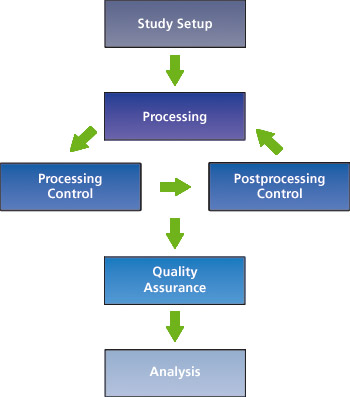And this is how it works:
verbaco supports you during the study setup,
the production process and even helps you with quality assurance and reporting.
You control every step in one application. This enables you to check any time,
the time of processing, the costs and the quality of your studies.

Step 1: Study Setup
- Start of the study with the main parameters such as: description, key e.g. cost unit, method of data collection and timing
- Definition of segments, assignment of codeframes to questions in a matrix-structure
- Upload of the segments, codeframes in the order of already existing codeframes, or basic structure if the sketching function is used
- Qualifying of the codeframe through the sketching function
Step 2: Processing
- Activation of the study with allocation of user rights
- Upload of verbatims assigning them to language and questions
- Coding with the possibility of codeframe extension, quality assurance with supervision of the postprocessing
Step 3: Processing Control
- Online statistics and monitoring of processing and coding time
- Online coaching through an integrated chatroom
Step 4: Postprocessing
- recoding of wrongly coded verbatims
Step 5: Quality Assurance
- Quality check of random sized samples
- Re-entering of verbatims in the coding process
Step 6: Analysis
- "On the fly" processing of the topliner
- Re-assigning and merging of codes
Step 1 - Study Setup:
- Start of the study with the main parameters such as: description, key e.g. cost unit, method of data collection and timing
- Definition of segments, assignment of codeframes to questions in a matrix-structure
- Upload of the segments, codeframes in the order of already existing codeframes, or basic structure if the sketchfunction is used
- Qualifying of the codeframe through the sketching function
Step 2 - Processing:
- Activation of the study with allocation of user rights
- Upload of verbatims assigning them to language and questions
- Coding with the possibility of codeframe extension, quality assurance with supervision of the postprocessing
Step 3 - Processing Control:
- Online statistics and monitoring of processing and coding time
- Online coaching through an integrated chatroom
Step 4 - Postprocessing:
- recoding of wrongly coded verbatims
Step 5 - Quality Assurance:
- Quality check of random sized samples
- Re-entering of verbatims in the coding process
Step 6 - Analysis:
- "On the fly" processing of the topliner
- Re-assigning and merging of codes


